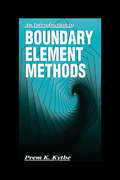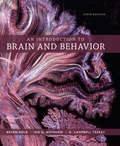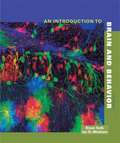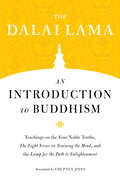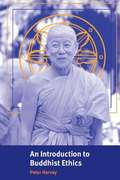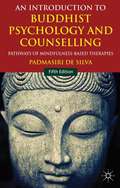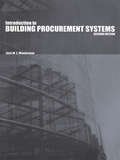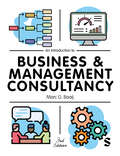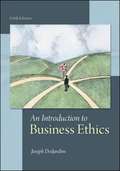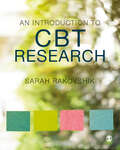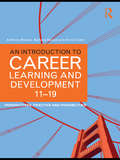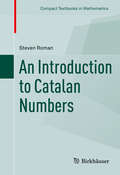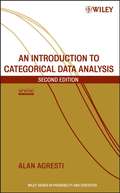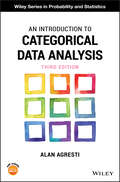- Table View
- List View
An Introduction to Boundary Element Methods (Symbolic And Numeric Computation Ser. #4)
by Prem K. KytheThe finite element and the boundary element methods are the two most important developments in numerical mathematics to occur in this century. Many engineering and mathematics graduate curricula now include a course in boundary element methods. Such a course must cover numerical methods, basic methodology to real problems, and interactive computer usage. Both theory and applications, necessary for applied courses, are available in this new textbook.An Introduction to Boundary Element Methods is logically organized and easy to read. The topics are carefully selected and meticulously presented. Applications are described for use in identifying potential problems and for heat transfer, diffusion equations, linear elasticity, water waves, ocean acoustics, acoustic scattering, aerodynamics, porous media, and simple laminar flows.More than 20 computer subroutines help develop and explain the computational aspect of the subject. Hundreds of figures, exercises, and solved examples supplement text and help clarify important information.The computer programs have been tested on some benchmark problems. Even in single precision the results are more accurate and better than those obtained from available Fortran programs.
An Introduction to Brain and Behavior
by Bryan Kolb Ian Q. Whishaw G. Campbell TeskeyFrom authors Bryan Kolb and Ian Whishaw, and new coauthor G. Campbell Teskey, An Introduction to Brain and Behavior offers a unique inquiry-based introduction to behavioral neuroscience, with each chapter focusing on a central question (i. e. , "How Does the Nervous System Function?"). It also incorporates a distinctive clinical perspective, with examples showing students what happens when common neuronal processes malfunction. Now this acclaimed book returns in a thoroughly up-to-date new edition. Founders of a prestigious neuroscience institute at the University of Lethbridge in Alberta, Canada, Kolb and Whishaw are renowned as both active scientists and teachers. G. Campbell Teskey of the University of Calgary, also brings to the book a wealth of experience as a researcher and educator. Together, they are the ideal author team for guiding students from a basic understanding the biology of behavior to the very frontiers of some of the most exciting and impactful research being conducted today. The new edition also has its own dedicated version of Worth Publishers' breakthrough online course space, LaunchPad, giving it the most robust media component of any textbook for the course.
An Introduction to Brain and Behavior
by Bryan Kolb Ian Whishaw G. TeskeyFrom authors Bryan Kolb, Ian Whishaw, and G. Campbell Teskey, An Introduction to Brain and Behavior offers a unique inquiry-based approach to behavioral neuroscience with each chapter focusing on a central question (i.e., How Does the Nervous System Function?). The authors emphasize a distinctive clinical perspective, with examples that show students what happens when common neuronal processes malfunction. The new edition continues the Brain and Behavior tradition of incorporating the latest research throughout the book. Revisions include new material discussing current research on genetic mosaics and modification, including transgenic techniques and optogenetic techniques, neurotransmitters, hormones, brain development in adolescence, psychobiotics, color perception, and biorhythms, as well as updates to the discussion of specific disorders to reflect the current state of understanding, including Parkinson’s disease, Alzheimer’s disease, depression and drug dependency, sleep disorders, schizophrenia, glaucoma, and abnormal development related to prenatal experience.
An Introduction to Brain and Behavior
by Bryan Kolb Ian Whishaw G. TeskeyThe new edition of An Introduction to Brain & Behavior takes you the frontiers of the study and practice of behavioral neuroscience.
An Introduction to Brain and Behavior,Third Edition
by Bryan Kolb Ian Q. WhishawThe distinctive approach to contemporary brain science engages students by answering the basic questions about the interplay between brain and behavior --answers that incorporate the latest clinical and technological developments in research with fascinating case studies.
An Introduction to Buddhism
by Peter HarveyThis extensively revised and updated second edition draws upon recent scholarship to present a comprehensive overview of the development of Buddhism in Asia and the West. Detailed references to secondary literature and a section on web resources make it ideal for students of religion, philosophy or Asian studies.
An Introduction to Buddhism (Core Teachings of Dalai Lama)
by The Dalai LamaThe "Core Teachings of the Dalai Lama" series begins with this small book of teachings by His Holiness, the perfect introduction to traditional Tibetan Buddhist thought and practice.There is no one more suited to introduce beginners—and remind seasoned practitioners— of the fundamentals of Tibetan Buddhism than His Holiness the Dalai Lama. Speaking to an audience of Western students, the Dalai Lama shows us how to apply basic Buddhist principles to our day-to-day lives. Starting with the very foundation of Buddhism, the Four Noble Truths, he provides the framework for understanding the Buddha’s first teachings on suffering, happiness, and peace. He follows with commentary on two of Buddhism’s most profound texts: The Eight Verses on Training the Mind and Atisha’s Lamp for the Path to Enlightenment, often referring to the former as one of his main sources of inspiration for the practice of compassion. With clear, accessible language and the familiar sense of humor that infuses nearly all of his work, the Dalai Lama invites us all to develop innermost awareness, a proper understanding of the nature of reality, and heartfelt compassion for all beings.This book was previously published under the title Lighting the Way.
An Introduction to Buddhist Ethics: Foundations, Values and Issues
by Peter HarveyThis systematic introduction to Buddhist ethics is aimed at anyone interested in Buddhism, including students, scholars and general readers. Peter Harvey is the author of the acclaimed Introduction to Buddhism (Cambridge, 1990), and his new book is written in a clear style, assuming no prior knowledge. At the same time it develops a careful, probing analysis of the nature and practical dynamics of Buddhist ethics in both its unifying themes and in the particularities of different Buddhist traditions. The book applies Buddhist ethics to a range of issues of contemporary concern: humanity's relationship with the rest of nature; economics; war and peace; euthanasia; abortion; the status of women; and homosexuality. Professor Harvey draws on texts of the main Buddhist traditions, and on historical and contemporary accounts of the behaviour of Buddhists, to describe existing Buddhist ethics, to assess different views within it, and to extend its application into new areas.
An Introduction to Buddhist Psychology and Counselling
by Padmasiri De SilvaThis book, now in its fifth edition, provides a comprehensive introduction to Buddhist psychology and counselling, exploring key concepts in psychology and practical applications in mindfulness-based counselling techniques using Buddhist philosophy of mind, psychology, ethics and contemplative methods.
An Introduction to Building Procurement Systems
by J.W.E. Masterman Dr Jack Masterman Jack MastermanFirst Published in 2003. Routledge is an imprint of Taylor & Francis, an informa company.
An Introduction to Business & Management Consultancy
by Marc G. BaaijThis textbook provides a clear and concise introduction to business and management consultancy. It will help you understand practices and techniques to hire and to implement business and management consultancy, giving you the essentials for success in your studies and later industries when working with - and not just for - consultancy firms. Built around learning objectives and providing engaging, real-life examples, this text empowers the reader to understand the ‘what’, ‘how’, ‘when’ and ‘why’ at macro and micro levels of business and management consultancy. As well as full courses on business and management consultancy, this textbook will be invaluable to your management knowledge and skill set across strategy, change, analytics, solution implementation and decision-making as applied by the world’s top management consultancy firms. It also includes a guide to McKinsey problem-solving methods. Dr Marc G. Baaij is Associate Professor of Strategic Management at the Rotterdam School of Management (RSM), Erasmus University Rotterdam.
An Introduction to Business & Management Consultancy
by Marc G. BaaijThis textbook provides a clear and concise introduction to business and management consultancy. It will help you understand practices and techniques to hire and to implement business and management consultancy, giving you the essentials for success in your studies and later industries when working with - and not just for - consultancy firms. Built around learning objectives and providing engaging, real-life examples, this text empowers the reader to understand the ‘what’, ‘how’, ‘when’ and ‘why’ at macro and micro levels of business and management consultancy. As well as full courses on business and management consultancy, this textbook will be invaluable to your management knowledge and skill set across strategy, change, analytics, solution implementation and decision-making as applied by the world’s top management consultancy firms. It also includes a guide to McKinsey problem-solving methods. Dr Marc G. Baaij is Associate Professor of Strategic Management at the Rotterdam School of Management (RSM), Erasmus University Rotterdam.
An Introduction to Business Ethics, 5th Edition
by Joseph DesjardinsSince its inception, An Introduction to Business Ethics by Joseph DesJardins has been a cutting-edge resource for the business ethics course. DesJardins’ unique multidisciplinary approach offers critical analysis and integrates the perspective of philosophy with management, law, economics, and public policy, providing a clear, concise, yet reasonably comprehensive introductory survey of the ethical choices available to us in business.
An Introduction to C*-Algebras and Noncommutative Geometry (Birkhäuser Advanced Texts Basler Lehrbücher)
by Heath EmersonThis is the first textbook on C*-algebra theory with a view toward Noncommutative Geometry. Moreover, it fills a gap in the literature, providing a clear and accessible account of the geometric picture of K-theory and its relation to the C*-algebraic picture. The text can be used as the basis for a graduate level or a capstone course with the goal being to bring a relative novice up to speed on the basic ideas while offering a glimpse at some of the more advanced topics of the subject. Coverage includes C*-algebra theory, K-theory, K-homology, Index theory and Connes’ Noncommuntative Riemannian geometry. Aimed at graduate level students, the book is also a valuable resource for mathematicians who wish to deepen their understanding of noncommutative geometry and algebraic K-theory. A wide range of important examples are introduced at the beginning of the book. There are lots of excellent exercises and any student working through these will benefit significantly. Prerequisites include a basic knowledge of algebra, analysis, and a bit of functional analysis. As the book progresses, a little more mathematical maturity is required as the text discusses smooth manifolds, some differential geometry and elliptic operator theory, and K-theory. The text is largely self-contained though occasionally the reader may opt to consult more specialized material to further deepen their understanding of certain details.
An Introduction to CBT Research
by Sarah RakovshikThis highly practical book will guide students through the different levels of research within CBT by addressing the general principles of grappling with evidence and understanding statistics. It also highlights how to critically engage with, interpret and evaluate research so that it can be used to shape practice. This important book will help readers see the relevance of research in their working lives and empower them to become active and keen researchers.
An Introduction to CBT Research
by Sarah RakovshikThis highly practical book will guide students through the different levels of research within CBT by addressing the general principles of grappling with evidence and understanding statistics. It also highlights how to critically engage with, interpret and evaluate research so that it can be used to shape practice. This important book will help readers see the relevance of research in their working lives and empower them to become active and keen researchers.
An Introduction to Capitalism
by Paul SwansonEmbedded in an historical account of the development of U.S. capitalism up to the present day, this book gives the reader a thorough description of the major aspects of the U.S. economy, as well as a theoretical understanding of the overall economy. A particular focus of this book is how free markets work in capitalism and the interrelationship between markets and the government. Of particular interest in the current economic situation is the question of what can the government do to get the economy going again. Underlying the standard economics text today is the fundamental belief that leaving markets as free as possible will lead to the ideal economy. Directly opposing this approach, this book takes a critical stance toward free markets. Rather than viewing markets as the ideal solution to almost all economic problems, this book argues that markets are not always the answer. On the contrary, they are often the problem, and must be corrected by government action. Related to this critical stance, and in a further departure from current economics texts, this book takes an explicitly Keynesian approach to the macro-economy. Rejecting the free market approach which dominates both micro- and macro-economics today, this book offers a fresh perspective on economics and the economy today.
An Introduction to Career Learning & Development 11-19: Perspectives, Practice and Possibilities
by Barbara Bassot Anthony Barnes Anne ChantAn Introduction to Career Learning and Development 11-19 is an indispensible source of support and guidance for all those who need to know why and how career learning and development should be planned, developed and delivered effectively to meet the needs of young people. It is a comprehensive resource providing a framework for career education conducive with the realities of lifelong learning, enterprise, flexibility and resilience in a dynamic world. It discusses the key under-pinning theory and policies and provides straight-forward, practical advice for students and practising professionals. Experts in the field provide essential guidance on: development and leadership of career education strategies in school planning and implementing career learning activities in the curriculum collaborative working and engagement between schools, colleges and Connexions services, as well as with parents, community and business organisations key organisations and where to find useful resources effective teaching and learning - active, participative and experiential learning approaches issues of ethics, values, equality and diversity guidance on self-evaluation, making the most of inspection, and quality standards and awards. An Introduction to Career Learning and Development 11-19 is an invaluable guide for teachers, teaching support staff, careers guidance professionals and all other partners in the delivery of CEIAG who wish to enhance their understanding of current and emerging practice and provide support that can really make a difference to young people’s lives.?
An Introduction to Catalan Numbers (Compact Textbooks in Mathematics)
by Steven RomanThis textbook provides an introduction to the Catalan numbers and their remarkable properties, along with their various applications in combinatorics. Intended to be accessible to students new to the subject, the book begins with more elementary topics before progressing to more mathematically sophisticated topics. Each chapter focuses on a specific combinatorial object counted by these numbers, including paths, trees, tilings of a staircase, null sums in Zn+1, interval structures, partitions, permutations, semiorders, and more. Exercises are included at the end of book, along with hints and solutions, to help students obtain a better grasp of the material. The text is ideal for undergraduate students studying combinatorics, but will also appeal to anyone with a mathematical background who has an interest in learning about the Catalan numbers. "Roman does an admirable job of providing an introduction to Catalan numbers of a different nature from the previous ones. He has made an excellent choice of topics in order to convey the flavor of Catalan combinatorics. [Readers] will acquire a good feeling for why so many mathematicians are enthralled by the remarkable ubiquity and elegance of Catalan numbers. " - From the foreword by Richard Stanley
An Introduction to Categorical Data Analysis
by Alan AgrestiThe use of statistical methods for categorical data is ever increasing in today's world. An Introduction to Categorical Data Analysis, Second Edition provides an applied introduction to the most important methods for analyzing categorical data. This new edition summarizes methods that have long played a prominent role in data analysis, such as chi-squared tests, and also places special emphasis on logistic regression and other modeling techniques for univariate and correlated multivariate categorical responses. This Second Edition features: Two new chapters on the methods for clustered data, with an emphasis on generalized estimating equations (GEE) and random effects models A unified perspective based on generalized linear models An emphasis on logistic regression modeling An appendix that demonstrates the use of SAS(r) for all methods An entertaining historical perspective on the development of the methods Specialized methods for ordinal data, small samples, multicategory data, and matched pairs More than 100 analyses of real data sets and nearly 300 exercises Written in an applied, nontechnical style, the book illustrates methods using a wide variety of real data, including medical clinical trials, drug use by teenagers, basketball shooting, horseshoe crab mating, environmental opinions, correlates of happiness, and much more. An Introduction to Categorical Data Analysis, Second Edition is an invaluable tool for social, behavioral, and biomedical scientists, as well as researchers in public health, marketing, education, biological and agricultural sciences, and industrial quality control.
An Introduction to Categorical Data Analysis (Wiley Series in Probability and Statistics #Vol. 308)
by Alan AgrestiA valuable new edition of a standard reference The use of statistical methods for categorical data has increased dramatically, particularly for applications in the biomedical and social sciences. An Introduction to Categorical Data Analysis, Third Edition summarizes these methods and shows readers how to use them using software. Readers will find a unified generalized linear models approach that connects logistic regression and loglinear models for discrete data with normal regression for continuous data. Adding to the value in the new edition is: • Illustrations of the use of R software to perform all the analyses in the book • A new chapter on alternative methods for categorical data, including smoothing and regularization methods (such as the lasso), classification methods such as linear discriminant analysis and classification trees, and cluster analysis • New sections in many chapters introducing the Bayesian approach for the methods of that chapter • More than 70 analyses of data sets to illustrate application of the methods, and about 200 exercises, many containing other data sets • An appendix showing how to use SAS, Stata, and SPSS, and an appendix with short solutions to most odd-numbered exercises Written in an applied, nontechnical style, this book illustrates the methods using a wide variety of real data, including medical clinical trials, environmental questions, drug use by teenagers, horseshoe crab mating, basketball shooting, correlates of happiness, and much more. An Introduction to Categorical Data Analysis, Third Edition is an invaluable tool for statisticians and biostatisticians as well as methodologists in the social and behavioral sciences, medicine and public health, marketing, education, and the biological and agricultural sciences.
An Introduction to Category Theory
by H. SimmonsCategory theory provides a general conceptual framework that has proved fruitful in subjects as diverse as geometry, topology, theoretical computer science and foundational mathematics. Here is a friendly, easy-to-read textbook that explains the fundamentals at a level suitable for newcomers to the subject. Beginning postgraduate mathematicians will find this book an excellent introduction to all of the basics of category theory. It gives the basic definitions; goes through the various associated gadgetry, such as functors, natural transformations, limits and colimits; and then explains adjunctions. The material is slowly developed using many examples and illustrations to illuminate the concepts explained. Over 200 exercises, with solutions available online, help the reader to access the subject and make the book ideal for self-study. It can also be used as a recommended text for a taught introductory course.
An Introduction to Catholic Ethics since Vatican II
by Andrew KimThis introduction provides a comprehensive overview of the development of Catholic ethics in the wake of the Second Vatican Council (1962–5), an event widely considered crucial to the reconciliation of the Catholic Church and the modern world. Andrew Kim investigates Catholic responses to questions of moral theology in all four principal areas: Catholic social teaching, natural law, virtue ethics, and bioethics. In addition to discussing contemporary controversies surrounding abortion, contraception, labor rights, exploitation of the poor, and just war theory, he explores the historical sources of the Catholic worldview. Beginning with the moral vision revealed through the person of Jesus Christ and continuing with elaborations on this vision from figures such as Augustine and Aquinas, this volume elucidates the continuity of the Catholic moral tradition. Its balance of complexity and accessibility makes it an ideal resource for both students of theology and general readers.
An Introduction to Celestial Mechanics
by Richard FitzpatrickThis accessible text on classical celestial mechanics, the principles governing the motions of bodies in the Solar System, provides a clear and concise treatment of virtually all of the major features of solar system dynamics. Building on advanced topics in classical mechanics such as rigid body rotation, Langrangian mechanics, and orbital perturbation theory, this text has been written for advanced undergraduates and beginning graduate students in astronomy, physics, mathematics, and related fields. Specific topics covered include Keplerian orbits, the perihelion precession of the planets, tidal interactions between the Earth, Moon, and Sun, the Roche radius, the stability of Lagrange points in the three-body problem, and lunar motion. More than 100 exercises allow students to gauge their understanding, and a solutions manual is available to instructors. Suitable for a first course in celestial mechanics, this text is the ideal bridge to higher level treatments.
An Introduction to Celestial Mechanics (Dover Books on Astronomy)
by Forest Ray MoultonAn unrivaled text in the field of celestial mechanics, Moulton's theoretical work on the prediction and interpretation of celestial phenomena has not been superseded. By providing a general account of all parts of celestial mechanics without an over-full treatment of any single aspect, by stating all the problems in advance, and, where the transformations are long, giving an outline of the steps which must be made, and by noting all the places where assumptions have been introduced or unjustified methods employed, Moulton has insured that his work will be valuable to all who are interested in the subject.The text is divided into ten chapters which progress logically in terms of the difficulty of their subject matter. They are: Fundamental Principles and Definitions, Rectilinear Motion, Central Forces, The Potential and Attractions of Bodies, The Problem of Two Bodies, The Determination of Orbits, The General Integrals of the Problem of n Bodies, The Problem of Three Bodies, Perturbations - Geometrical Considerations, and Perturbations - Analytical Method. Important topics cove red include general equations, motion of falling particles, the heat of the sun, simultaneous differential equations, examples where J is a function of the coordinates alone, the universality of Newton's law, determination of the orbit from the law of force, attractions of simple solids, potential and attractions of simple bodies and ellipsoids, Ivory's method and level surfaces, elements of orbits, expansions and positions in orbits, transformations of coordinates, the Laplacian and Gaussian methods of determining orbits, motion of center of mass and area integrals, motion of the infinitesimal body, surfaces of zero relative velocity, effects of the components of the disturbing force, lunar theory, method of computing perturbations, and the perturbative function.Each chapter is followed by a historical sketch and bibliography pertaining to that subject. Over 200 problems appear at key points in the text, many of them answered.
